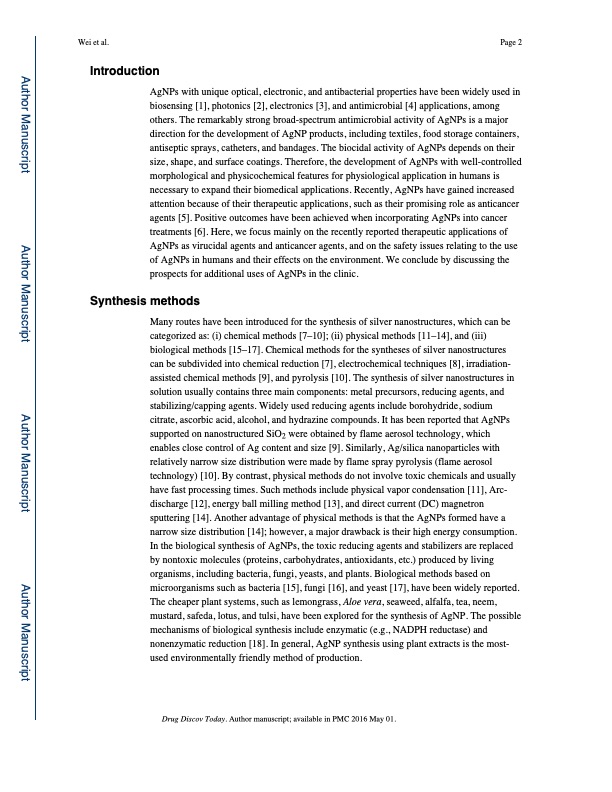
PDF Publication Title:
Text from PDF Page: 002
Wei et al. Page 2 Introduction AgNPs with unique optical, electronic, and antibacterial properties have been widely used in biosensing [1], photonics [2], electronics [3], and antimicrobial [4] applications, among others. The remarkably strong broad-spectrum antimicrobial activity of AgNPs is a major direction for the development of AgNP products, including textiles, food storage containers, antiseptic sprays, catheters, and bandages. The biocidal activity of AgNPs depends on their size, shape, and surface coatings. Therefore, the development of AgNPs with well-controlled morphological and physicochemical features for physiological application in humans is necessary to expand their biomedical applications. Recently, AgNPs have gained increased attention because of their therapeutic applications, such as their promising role as anticancer agents [5]. Positive outcomes have been achieved when incorporating AgNPs into cancer treatments [6]. Here, we focus mainly on the recently reported therapeutic applications of AgNPs as virucidal agents and anticancer agents, and on the safety issues relating to the use of AgNPs in humans and their effects on the environment. We conclude by discussing the prospects for additional uses of AgNPs in the clinic. Synthesis methods Many routes have been introduced for the synthesis of silver nanostructures, which can be categorized as: (i) chemical methods [7–10]; (ii) physical methods [11–14], and (iii) biological methods [15–17]. Chemical methods for the syntheses of silver nanostructures can be subdivided into chemical reduction [7], electrochemical techniques [8], irradiation- assisted chemical methods [9], and pyrolysis [10]. The synthesis of silver nanostructures in solution usually contains three main components: metal precursors, reducing agents, and stabilizing/capping agents. Widely used reducing agents include borohydride, sodium citrate, ascorbic acid, alcohol, and hydrazine compounds. It has been reported that AgNPs supported on nanostructured SiO2 were obtained by flame aerosol technology, which enables close control of Ag content and size [9]. Similarly, Ag/silica nanoparticles with relatively narrow size distribution were made by flame spray pyrolysis (flame aerosol technology) [10]. By contrast, physical methods do not involve toxic chemicals and usually have fast processing times. Such methods include physical vapor condensation [11], Arc- discharge [12], energy ball milling method [13], and direct current (DC) magnetron sputtering [14]. Another advantage of physical methods is that the AgNPs formed have a narrow size distribution [14]; however, a major drawback is their high energy consumption. In the biological synthesis of AgNPs, the toxic reducing agents and stabilizers are replaced by nontoxic molecules (proteins, carbohydrates, antioxidants, etc.) produced by living organisms, including bacteria, fungi, yeasts, and plants. Biological methods based on microorganisms such as bacteria [15], fungi [16], and yeast [17], have been widely reported. The cheaper plant systems, such as lemongrass, Aloe vera, seaweed, alfalfa, tea, neem, mustard, safeda, lotus, and tulsi, have been explored for the synthesis of AgNP. The possible mechanisms of biological synthesis include enzymatic (e.g., NADPH reductase) and nonenzymatic reduction [18]. In general, AgNP synthesis using plant extracts is the most- used environmentally friendly method of production. Drug Discov Today. Author manuscript; available in PMC 2016 May 01. Author Manuscript Author Manuscript Author Manuscript Author ManuscriptPDF Image | Silver nanoparticles: synthesis, properties, therapeutic apps

PDF Search Title:
Silver nanoparticles: synthesis, properties, therapeutic appsOriginal File Name Searched:
nihms651778.pdfDIY PDF Search: Google It | Yahoo | Bing
Turbine and System Plans CAD CAM: Special for this month, any plans are $10,000 for complete Cad/Cam blueprints. License is for one build. Try before you buy a production license. More Info
Waste Heat Power Technology: Organic Rankine Cycle uses waste heat to make electricity, shaft horsepower and cooling. More Info
All Turbine and System Products: Infinity Turbine ORD systems, turbine generator sets, build plans and more to use your waste heat from 30C to 100C. More Info
CO2 Phase Change Demonstrator: CO2 goes supercritical at 30 C. This is a experimental platform which you can use to demonstrate phase change with low heat. Includes integration area for small CO2 turbine, static generator, and more. This can also be used for a GTL Gas to Liquids experimental platform. More Info
Introducing the Infinity Turbine Products Infinity Turbine develops and builds systems for making power from waste heat. It also is working on innovative strategies for storing, making, and deploying energy. More Info
Need Strategy? Use our Consulting and analyst services Infinity Turbine LLC is pleased to announce its consulting and analyst services. We have worked in the renewable energy industry as a researcher, developing sales and markets, along with may inventions and innovations. More Info
Made in USA with Global Energy Millennial Web Engine These pages were made with the Global Energy Web PDF Engine using Filemaker (Claris) software.
Infinity Turbine Developing Spinning Disc Reactor SDR or Spinning Disc Reactors reduce processing time for liquid production of Silver Nanoparticles.
| CONTACT TEL: 608-238-6001 Email: greg@infinityturbine.com | RSS | AMP |